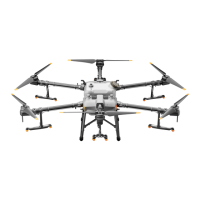before cleaning the remaining water residue with a dry cloth.
5. Store the cleaned aircraft in a dry environment.
2. Wipe the surface and screen of the remote controller with a clean wet cloth that has been wrung out with water
daily after operations.
3. Inspect the aircraft every 100 flights or after flying for over 20 hours:
1. Check for and replace worn propellers.
2. Check for loose propellers. Replace propellers and propeller washers if needed.
3. Check for aging plastic or rubber parts.
4. Check for poor atomization of the nozzles. Clean nozzles thoroughly or replace them.
5. Replace nozzle strainers and the spray tank strainer.
4. DO NOT attempt to repair the aircraft. Contact DJI Support or a DJI authorized dealer if any parts are
damaged.
Notice
1. Keep the protective cover of the radar module clean. Clean the surface with a soft damp cloth and air dry
before using again.
2. Keep the FPV camera clean. First remove any larger pieces of grit or sand then wipe the lens with a clean, soft
cloth to remove dust or other dirt.
3. In the event of a crash or collision, make sure to thoroughly inspect every part of the aircraft and make any
necessary repairs and replacements before your next flight. If you have any problems or questions, contact DJI
Support or a DJI authorized dealer.
Flight Condition Requirements
Weather Conditions and Surrounding Environment
Warning
The aircraft is designed to operate in good to moderate weather conditions. To avoid collision, serious injury,
property damage or imposing health hazards, observe the following rules:
1. DO NOT use the aircraft in adverse weather conditions such as winds exceeding 28 kph (17 mph), heavy rain
(precipitation rate exceeding 25 mm (0.98 in) in 12 hours), snow, or fog.
2. To prevent health hazards to nearby people and to ensure effective spray, operate the aircraft to spray in wind
speeds below 18 kph (11 mph).
3. Keep the aircraft at least 10 m (30 ft) away from obstacles, people, animals, buildings, public infrastructure, and
bodies of water when in flight. As the aircraft’s altitude increases, keep an even further distance away from the
aforementioned objects or obstacles.
4. DO NOT fly over 4.5 km (14,763 ft) above sea level.
5. The DJI Agras app will intelligently recommend the payload weight of the tank according to the current status
and surroundings of the aircraft. When adding material to the tank, the max weight should not exceed the
recommended value. Otherwise, the flight safety may be affected.
6. DO NOT operate any part of the aircraft indoors.

